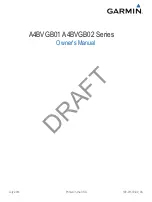
Model: MC-1-M (2U)
Doc. Ref. no. : m05/om/101
Issue no. 14
User’s Manual
Page 68 of 103
11.2.2.1
Standard IRIG-B Output:
As per figure 5.2, GPS Master Clock model MC-1-M model has two, BNC, connectors that supply timing
signals to external equipment. One of output is designed for IRIG-B AM and other for IRIG-B DCLS.
Figure 5.8 shows the same two ports referenced as IRIG-B TTL.
GPS Master Clock model MC-1-M model is available with max 8 no of IRIG-B DCLS/IRIG-B AM outputs
as optional which vary considering other optional output types provided.
NOTE: On the back terminal plate of model MC-1-M IRIG-B DCLS time code signal is referred as IRIG-B
TTL.
11.2.2.2
Abstract of IRIG-B Time Code:
The transmission of coded timing signals began to take on widespread importance in the early 1950’s.
Especially the US missile and space programs were the forces behind the development of these time
codes. The definition of time code formats was completely arbitrary and left to the individual ideas of each
design engineer due to that hundreds of different time codes were formed, some of which were
standardized by the "Inter Range Instrumentation Group" (IRIG) in the early 60’s.
Today electronic systems such as communication system, data handling systems require time of day/year
for data correlation of data with time. IRIG-B is a serial time code that occurs once per second and
depending protocol it contains day of year, hour, minute, seconds, year and other important information.
Except these, "IRIG Time Code” other format like IEEE1344 code which is an IRIG coded extended by
information for time zone, leap second, etc.
IRIG-B fully described in IRIG Standard 200-04, released by RANGE COMMANDERS COUNCIL of the
US Army White Sands Missile Range. IRIG-B format standard allows number of configurations that
designated as IRIG-Bxyz, where x indicates the modulation technique, y indicates carrier signal frequency
and z indicates data contained in the signal. IRIG-B timecode consists of 100 bits out of 74 bit used for
time, date, and control functions. The 74 time code bits divided into:
30 bits for BCD value of Seconds, Minutes, Hours, and current day of the year
9 bits for year information
17 bits for binary value of current day seconds
18 bits for control functions Also unused bits are filled with logical zero.
11.2.2.3
IRIG-B AM & IRIG-B DCLS signals:
Figure illustrates primary difference between AM-Amplitude Modulated Signal and DCLS- (Pulse Width
Modulated Signal). IRIG-B AM is distinctive because of the 1 KHz sine wave carrier. It is similar to IRIG-B
DCLS, since Pick-Pick values of the carrier signal follow the same form as IRIG-B DCLS, which contains
information.















































